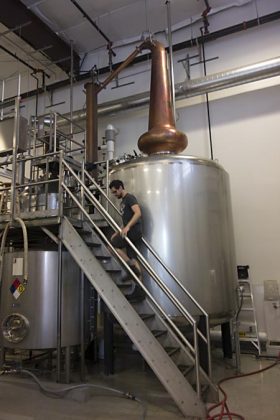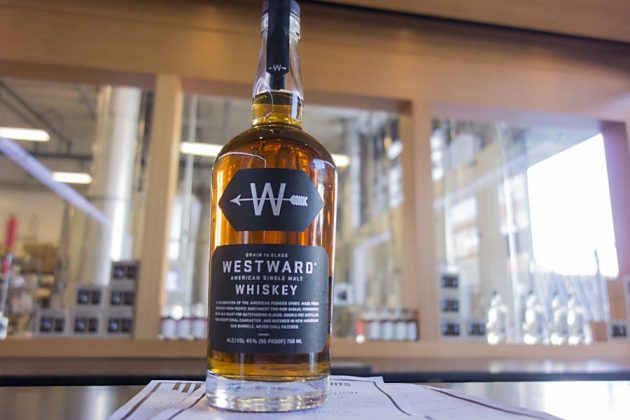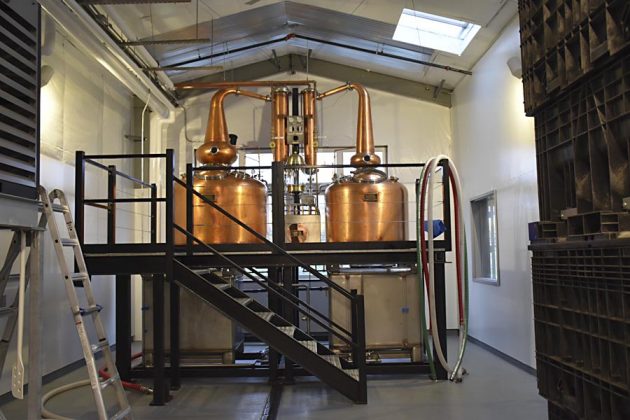As the craft-spirits industry expands and gains prominence nationwide, there has been an accompanying increase in scrutiny by building and fire officials. The applicable codes are often not well understood, not only by members of the distilling community, but also by agencies regulating it. The regulations are complicated, lengthy and sometimes contradictory. As a result, compliance with the regulations can be very expensive. For those considering starting or expanding a distillery, or for those under increased scrutiny from local officials, it is essential to understand the basics of the applicable regulations.
To get an idea of the breadth of regulations spread across thousands of pages, we will examine the differences in the ways the codes apply to two contrasting Oregon distillery projects—House Spirits Distillery in Portland and Branch Point Distillery in Dayton. The former is a high-volume distillery in an urban environment, and the latter is a one-man operation in a rural setting.
Looking at these two examples, though far from an exhaustive review, will reveal some of the basic regulatory concepts applicable to craft distilleries.
The Projects
Founded in 2004, House Spirits Distillery was, by early 2013, bursting at its seams. Sales of Aviation Gin had taken off and production of Westward Whiskey had expanded to the point where a much larger facility was needed. The company Co-founder Christian Krogstad wished to remain in the Portland industrial district where its existing distillery was located. A former three-sided storage shed was selected, and the process of transforming it into a functional distillery building began.
At about the same time, Portland neurologist Steven Day was making plans to begin a second career making whiskey, grain to glass. The decision to start a distillery was born out of his love for whiskey and his desire to use his background in organic and bio chemistry to a creative end. He purchased land in the Willamette Valley wine region, outside of Portland, where thriving wine tourism would likely drive traffic to his door. A new building would be constructed to include two pot stills, a brew house and tasting room, while an existing barn was designated for barrel storage. Day intended Branch Point to be, as much as possible, a one-man operation.
Codes
The relevant Oregon codes are the same in both locations and are based on amended versions of the International Building Code (IBC) and the International Fire Code (IFC). In addition, there are many other applicable codes and standards, the most important being the National Fire Protection Agency’s Flammable and Combustible Liquids Code (NFPA 30).
While both facilities share some important similarities—both produce whiskey, use Vendome pot stills and utilize buildings of humble origin—they differ significantly in production capacity. House Spirits is one of the largest craft distillers on the West Coast and makes a variety of spirits. Branch Point makes only whiskey in small quantities. As a result, each distillery had a different code-compliance path to follow. The first step, on both paths, was to prepare a document describing the entire production process, including the percentage of alcohol by volume and amount of spirits contained in each tank and still.
Occupancy and the Maximum Allowed Quantity
The IBC classifies every building by its use and designates a corresponding occupancy classification. Examples are: “A” for assembly, “B” for business, “F” for factories, “H” for hazardous and “S” for storage. When a building contains multiple uses, each part of the building containing a specific use is individually classified. For example, a factory with an attached office contains two different occupancies, “F” and “B.” Craft distilleries are generally classified as either an F-1, Moderate Hazard Industrial Occupancy, or an H-3, Hazardous Occupancy.
The critical factor in determining the applicable occupancy is the total quantity of spirits contained in a facility. If the facility contains a volume of spirits below a certain level, known as the Maximum Allowed Quantity (MAQ), it is considered an F-1 occupancy. Above this level, the facility is considered an H-3 occupancy, expanding the scope of regulations and the cost significantly.
The MAQ depends on a number of factors, such as: the flash and boiling point of the flammable liquid; if the liquid is in a closed or open process or tank; and whether the building is equipped with fire sprinklers. The MAQ for spirits most commonly found in distilleries is 30 gallons in open use and 120 gallons in closed use. Both quantities can be doubled if the building has a fire sprinkler system. Only liquids above 20% alcohol are included in the MAQ. Fermenters, mash tuns, kettles and other brewery equipment are not affected by the codes regulating distilled spirits and the distilling process.
Also, specifically excluded from MAQ calculations are the volumes of spirits in bottles and wood barrels. The bottle exclusion is only applicable to containers of 1.3 gallons or less.
For an F-1 occupancy, the MAQ is quite low: 240 gal. for a sprinkled building. To increase this allowable volume, buildings can be divided into control areas, which are portions of a building separated by fire-rated walls and floors. The MAQ is then applied individually to each control area. The number of control areas per floor, as well as the volume of distilled spirits allowed in each control area, are regulated by the IBC. For example: A one-story building may contain a maximum of four control areas, with each containing 100 percent of the MAQ. Therefore, the maximum volume of distilled spirits allowed for a one-story building with fire sprinklers and four control areas is: 240 gal. x 4 control areas = 960 gallons.
The following illustrates how occupancy classifications were applied to the two projects: House Spirits exceeded the MAQ limits and therefore fell within the H-3 occupancy group. However, only the distillery area itself was classified as H-3. The tasting room and office areas were respectively A-2 and B, while the brewery area and cased goods storage were designated F-1 and S-1. An H-3 occupancy, in this case, the distillery area, is required to be separated from all other occupancies by fire-rated walls, doors and windows.
Branch Point was able to maintain an F-1 classification—thereby avoiding some costly infrastructure—by carefully restricting batch size, filling barrels individually, immediately moving filled barrels to their separate barrel warehouse and sprinkling the building. One of the common disadvantages of rural settings is the lack of a municipal water supply. At Branch Point, the municipal water supply was extremely limited, so to provide adequate water for the fire sprinklers, and at considerable cost, a pond and fire pump were added to the project.
As a side note: In Oregon, at the time both projects were permitted, barrels were included in the MAQ. Although wood barrels had been specifically excluded in the Oregon Fire Code, the Building Code doesn’t contain a corresponding clause. Building officials looked to the Building Code and said they were included in the MAQ. Both projects were affected. In the case of Branch Point, the separate barrel warehouse was originally considered an H-3 occupancy. At House Spirits, only a limited number of barrels were able to be kept on-site in the H-3 occupancy area. Excess barrels were trucked to an off-site storage warehouse. During construction, state building officials issued a document accepting the Fire Code’s exclusion as applicable to the Building Code. Barrel warehouses became S-1 occupancies as long as they were separated from H-3 occupancies by one-hour construction. This change came too late to affect House Spirits’ production facility, although it did relax code requirements for their off-site barrel storage warehouse. In Branch Point’s case, the barrel warehouse occupancy changed from H-3 to S-1 and eliminated the requirement for fire sprinklers in the warehouse. Since the Oregon Codes are based on the International versions, this same issue may also crop up in other jurisdictions.
Important Concepts
Two concepts are important to understand when considering how the codes are applied to craft distilleries, open vs. closed systems and process vs. storage.
• Open vs. Closed Systems
The IBC and the IFC define an open system as one that is continuously open to the atmosphere during normal operations and where vapors are liberated, or the product is exposed during normal operations. Examples given in the codes are open vats or dipping tanks. Closed systems are defined as ones that remain closed to the atmosphere during normal operations, no vapors are emitted and the product is not exposed to the atmosphere. According to the IFC, when an open system exceeds MAQ (60 gal. in a sprinkled building), explosion control is required.
Since explosion control can be prohibitively expensive, it is very important to remain below MAQ with respect to open use or systems. The most common points where open use can present a problem are the discharge point from the condenser, and barrel-filling and dumping. At both House Spirits and Branch Point, parrots and the discharge to the receiver are enclosed in glass housings. Barrels are filled and emptied one at a time.
The hazard of released vapors presented by a briefly open hatch on a tank containing spirits at room temperature is very low. Unfortunately, the codes do not adequately address the low hazard presented by such situations.
• Process vs. Storage
Storage is defined in the IFC as the keeping, retention or leaving of hazardous materials in closed tanks or vessels, or vessels supplying operations. Connections that are made and broken, such as connections to a hose from a tanker truck, are required to be outside.
Process operations are defined as placing a material into action. Stills and bottling lines would clearly be classified as processing equipment.
At House Spirits, all tanks, other than the still receivers, were classified as storage tanks by city officials. This included gin infusion tanks, vodka processing tanks and proofing and bottling tanks, all essentially used for processing. There is also a large outside NGS storage tank, which clearly fits the code description of a storage tank, including an outside fill location. Because of the storage classification, the tanks were required to be built to UL142 standards, be equipped with normal and emergency vents to the exterior and have overfill protection. An additional requirement of three-foot spacing between tanks was successfully appealed based on the use of ethanol detectors. An appeal allowing normal venting to the interior was not successful, other than for the still receivers.
Detailed Regulations
There are many regulations that affect both above and below MAQ facilities. Some of the most important ones are discussed below.
Classification of Tanks
Requirements for tanks depend upon several factors in addition to being above or below MAQ. It is necessary to determine if the tanks are considered open or closed systems and if they are used for storage or process. The codes require storage tanks to be built to UL142 standards and be vented to the exterior as noted above in the discussion of House Spirits’ experience.
Valves
Automatic closing or self-closing valves are also required on tanks emptied or filled by a bottom outlet. Automatic closing valves are operated by a computer-controlled system, also known as a Programmable Logic Controller (PLC). Self-closing valves must be held open manually and are only appropriate for small tanks or very patient people. House Spirits’ tanks are equipped with valves actuated with compressed air and are controlled by a PLC. Compressed air was used to avoid having electrical equipment and wiring in classified electrical areas as described below.
Classified Electrical Areas
To prevent electrical sparks or heat (created by electrical devices and equipment) from igniting flammable vapors or dust, devices and wiring near potential sources of vapors (Class 1) or dust (Class 2) are required to be of special construction. In general, devices and equipment are approved for constant exposure (Division 1) or accidental short-term exposure (Division 2). Classified electrical requirements apply to all facilities whether above or below MAQ. In Oregon, barrel-storage facilities are exempted. Since classified electrical equipment can be very expensive, the most economical and safest strategy is to locate electrical devices and equipment outside of classified electrical areas where possible. Diagrams showing areas where classified electrical equipment and wiring were required were very helpful for both the building officials’ review and for the electricians installing the wiring and equipment.
Electrical bonding and grounding of electrical systems and equipment in classified areas is also required. Again, this is not dependent on the MAQ.
Grain Milling Areas
Both facilities include grist mills, flexible screw conveyors and dust collection systems. Provisions in the IBC require dust-producing grinding operations to be in an H-2 occupancy with fire-rated walls. The H-2 classification is more restrictive than H-3. The House Spirits mill was housed in an enclosed shed outside of the main building. The first attempt was to classify the grist mill shed as a non-rated, F-1 occupancy because the hazard was mitigated by the dust-collection system. Building officials did not agree and required an H-2 occupancy and fire-rated walls. Although there are many Portland breweries with milling operations, which were permitted, but did not comply with these code provisions, the new distillery was held to higher standards than breweries with similar equipment. After House Spirits was completed and in use, Portland changed its attitude toward milling operations and now allows them without the H-2 occupancy and fire separation, as long as they have an approved dust-control system.
In Branch Point’s case, the mill is adjacent to its kettle and is not enclosed. Building and fire officials recognized the limited hazard involved with small milling operations outfitted with dust collection and did not require an H-2 occupancy or fire-rated enclosure.
Hazardous Materials Reports
According to the IFC, the local fire official may require operators of hazardous occupancies to provide a Hazardous Materials Management Plan and a Hazardous Materials Inventory Statement. In addition, the IBC requires a hazardous materials technical opinion and report if any hazardous materials are being used or stored. These reports must be prepared by a qualified person approved by the building official. The House Spirits reports were prepared by local hazardous materials code consultant Rich Miller.
Building and fire officials did not require Branch Point to prepare these reports.
Seismic Protection
Tanks and equipment are required to be braced and/or anchored. In both facilities, a structural engineer was required to calculate the size and number of anchor bolts needed to resist seismic forces.
Additional Code Requirements When the MAQ Is Exceeded
There are many additional regulations, which apply when a facility exceeds the MAQ per control area. Other than installing fire sprinklers to allow for an increase in the MAQ, Branch Point did not have to implement any of the following measures.
Sprinklers
A fire sprinkler system is required in all H-3 occupancies. The amount of water discharged by the sprinklers, in gallons per square feet per minute, is determined by use. A complicating factor was determining the proper sprinkler discharge rate for barrel storage. The House Spirits tank areas require 0.25 gallons per minute per square foot while the barrel storage area requires 0.60 gallons per minute per square foot. Applicable standards do not address wood barrel storage of distilled spirits directly. The fire-protection engineer used sources outside of the relevant codes and standards, which were then applied conservatively, resulting in a high rate of sprinkler discharge.
Spill Control and Secondary Containment
In H-3 occupancies, flammable liquid storage and processing areas are required to contain spills and 20 minutes’ worth of sprinkler water flow. In House Spirits’ case, the spirits portion of this volume is contained inside by a low curb around the tank and still area. Additional water from fire sprinklers overflows into a drain, which directs the additional volume to an exterior sump also serving as secondary containment for a large exterior spirit tank.
Continuous Ventilation
To prevent the accumulation of flammable vapors, the code requires continuous ventilation of the H-3 area. The minimum rate is one cubic foot per minute per square foot. Since House Spirits’ volume is fairly large, thousands of cubic feet per minute of air is required. When needed, the air is preheated for freeze protection. An emergency backup generator is also required to supply electricity to the system during electrical power interruptions.
Emergency Alarm System
A manual emergency alarm system is required in rooms used for the storage of hazardous materials and all alarm systems must be monitored by a monitoring service. House Spirits prepared a matrix indicating all emergency alarm conditions and the appropriate control action taken in response, which were then tested and approved by city officials.
Conclusion
While both House Spirits and Branch Point successfully maneuvered through the complex regulations governing the construction of distilleries, House Spirits faced a much more complex task due to its size and urban location. Important to both projects was having knowledgeable consultants, suppliers and contractors. Communication between officials and the design and construction teams was not always easy. Frank, comprehensive discussion with building and fire officials early on will make it possible to avoid pitfalls along the way.













